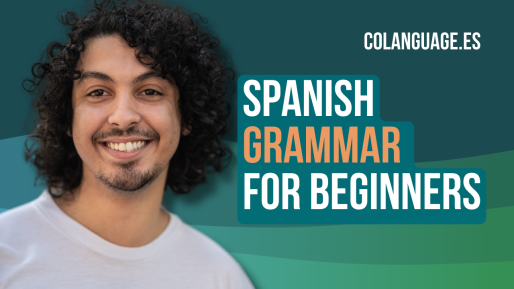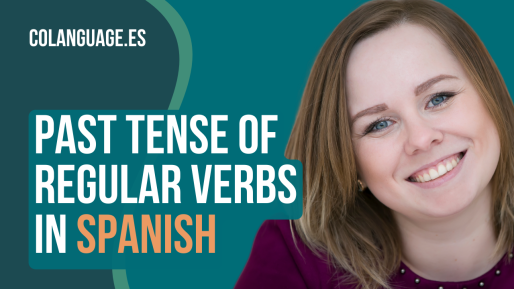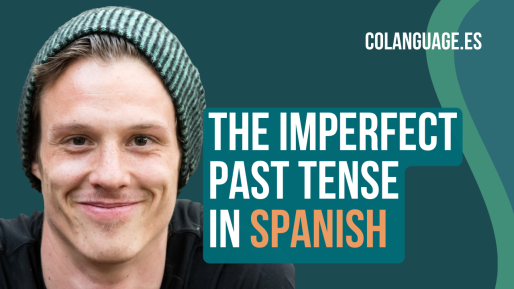Present perfect tense: conjugation of Spanish regular verbs Share Copied!
Spanish
Learn the present perfect tense in Spanish. Here you find exercises and audio materials that complement our conversation classes.
Video
Podcast
What is the present perfect tense?
The present perfect tense is used to describe actions that have occurred in the past and have relevance or a connection to the present.
-
He terminado mis deberes. (I have finished my homework.) it happened in the past but has connection to present
-
Aún no hemos ido a tu casa. (We haven’t been to your house yet.)it hasn't happened yet
How is the present perfect formed?
The present perfect tense is formed using the auxiliary verb "haber" (to have) conjugated in the present tense, followed by the past participle of the main verb.
"Haber" (to have) is an auxiliary verb used to form compound tenses, like the present perfect.
Present Perfect = Simple Present of "haber" (to have) + Past Participle of verb
Present perfect tense of Spanish verbs ending in "-ar"
This table shows the conjugation of the verb "comprar" (to buy) in the present perfect tense in Spanish.
| Personal pronoun | Spanish | English |
|---|---|---|
| Yo (I) | Yo he comprado un nuevo vestido. | I have bought a new dress. |
| Tú (You) | Tú has comprado tu comida favorita. | You have bought your favourite food. |
| Él/Ella (He/She/It) | Ella ha comprado un coche nuevo. | She has bought a new car. |
| Nosotros/-as (We) | Nosotras aún no hemos comprado los regalos para la familia. | We have not bought gifts for the family yet. |
| Vosotros/-as (You) | ¿Habéis comprado entradas para el espectáculo? | Have you bought tickets for the show? |
| Ellos/-as (They) | Ellos han comprado una casa en la playa. | They have bought a house at the beach. |
The present perfect used to describe a situation that has not happened yet.
Aún no he ido al médico. (I have not gone to the doctor yet.)
Listening exercise
The following dialogue shows you the use of the verbs ending in "-ar" in the present perfect tense.
| Spanish | English | |
|---|---|---|
| Daniel | ¿Has comprado los boletos para el concierto? |
Have you bought the tickets for the concert? |
| María | Sí, los he comprado esta mañana. |
Yes, I have bought them this morning. |
| Daniel | ¿Y vosotros dónde los habéis comprado? |
And where have you bought them? |
| María |
Los hemos comprado en la tienda del centro. |
We have bought them at the store downtown. |
Present perfect tense of Spanish verbs ending in "-er"
The following table will show you the conjugation of the verb "aprender" (to learn) in the present perfect tense.
| Personal pronoun | Spanish | English |
|---|---|---|
| Yo (I) |
Yo he aprendido mucho sobre historia recientemente. |
I have learnt a lot about history recently. |
| Tú (You) | Tú has aprendido a tocar la guitarra este año. |
You have learnt to play the guitar this year. |
| Él/Ella (He/She/It) |
Él ha aprendido un nuevo idioma. |
He has learnt a new language. |
| Nosotros/-as (We) |
Nosotros hemos aprendido a cocinar platos tradicionales. |
We have learnt to cook traditional dishes. |
| Vosotros/-as (You) |
Vosotras habéis aprendido a bailar salsa. |
You have learnt to dance salsa. |
| Ellos/-as (They) |
Ellas han aprendido sobre nuevas tecnologías. |
They have learnt about new technologies. |
The present perfect tense is used to describe actions that began in the past and are still ongoing.
Tú has aprendido a tocar la guitarra este año. (You have learnt to play the guitar this year.)
Listening exercise
This table shows you a dialogue as a listening exercise with the verb "aprender" (to learn).
| Spanish | English | |
|---|---|---|
| Daniel |
¿Has aprendido algo interesante últimamente? |
Have you learnt something interesting lately? |
| María |
Sí, he aprendido a tocar el piano. |
Yes, I have learnt to play the piano. |
| Daniel |
¡Qué divertido! Mi hermana y yo hemos aprendido a cantar. |
How fun! My sister and I have learnt to sing. |
| María |
Eso suena genial. ¿Dónde habéis aprendido? |
That sounds great. Where have you learnt? |
Note that the past participle for verbs ending in "-er" is the same ending as for those verbs ending in "-ir".
Present perfect tense of Spanish verbs ending in "-ir"
You will now learn how to conjugate the verb "añadir" (to add) in the present perfect tense.
| Personal pronoun | Spanish | English |
|---|---|---|
| Yo (I) |
Aún no he añadido sal a la salsa. |
I have not yet added salt to the sauce. |
| Tú (You) |
Tú has añadido una nueva receta al libro de cocina. |
You have added a new recipe to the cookbook. |
| Él/Ella (He/She/It) |
Ella ha añadido un capítulo interesante al libro. |
She has added an interesting chapter to the book. |
| Nosotros/-as (We) |
Nosotros hemos añadido más artículos a la lista de compras. |
We have added more items to the shopping list. |
| Vosotros/-as (You) |
Vosotras habéis añadido un toque personal a la decoración. |
You have added a personal touch to the decoration. |
| Ellos/-as (They) |
Ellos han añadido una nota personal al regalo. |
They have added a personal note to the gift. |
The present perfect tense is used to talk about an action that happened sometime not specified in the past.
Tú has añadido una nueva receta al libro de cocina. (You have added a new recipe to the cookbook.)
Listening exercise
Now you can practise the verbs ending in "-ir" with this short dialogue.
| Spanish | English | |
|---|---|---|
| Daniel |
¿Has añadido algo nuevo al proyecto? |
Have you added anything new to the project? |
| María |
Sí, he añadido algunas ideas creativas que podrían mejorarlo. |
Yes, I have added some creative ideas that could enhance it. |
| Daniel |
¡Eso suena genial! Nosotros también hemos añadido algunos cambios al plan. |
That sounds great! We also have added some changes to the plan. |
Key takeaways
Here is a quick summary of this lesson.
- The present perfect tense is used to describe actions that have occurred in the past and have a connection to the present.
- The present perfect tense is also used to talk about a situation that hasn't happened yet.
- The present perfect tense is can be used to talk about an action that happened sometime not specified in the past
- It is formed by using the auxiliary verb "haber" (to have) in the present tense, followed by the past participle of the main verb.
Subscribe to our social media channels to get free daily exercises!



